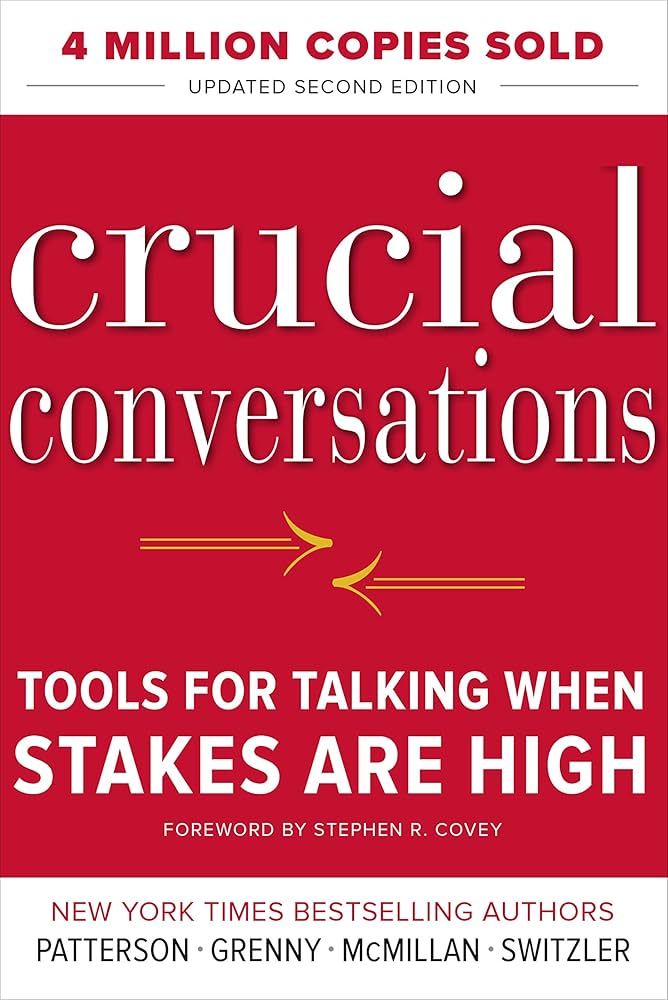
The second edition of *Crucial Conversations: Tools for Talking When Stakes Are High*, authored by Kerry Patterson, Joseph Grenny, Ron McMillan, and Al Switzler, published in 2012 by McGraw-Hill, presents a comprehensive framework for managing high-stakes dialogues in personal, professional, and organizational contexts. Building on empirical research and practical insights derived from over two decades of studying effective communicators, the book equips readers with actionable strategies to transform potentially volatile interactions into productive outcomes. With forewords by Stephen R. Covey emphasizing the transformative power of dialogue in an increasingly interdependent world, the text underscores how mastering these skills can enhance relationships, resolve conflicts, and drive positive change.
At its core, the book defines a “crucial conversation” as any discussion where opinions vary, stakes are high, and emotions run strong—scenarios that often lead to avoidance, aggression, or suboptimal results if mishandled. The authors argue that individuals who excel in these moments—termed “dialogue masters”—achieve better health, stronger relationships, and superior performance in various domains, supported by data from studies involving thousands of participants. The updated edition incorporates new research, case studies, and resources, including expanded discussions on virtual communication, cultural influences, and long-term application, reflecting lessons learned since the first edition’s release in 2002.
Structured across eleven chapters, the book systematically builds a skill set for navigating crucial conversations. Chapter 1 introduces the concept and its significance, illustrating how avoidance or poor handling exacerbates problems in families, teams, and societies. Chapter 2 explores the “power of dialogue,” positing that open, honest exchange fosters mutual understanding and synergy, drawing on Covey’s notion of a “third alternative” beyond compromise.
Subsequent chapters delve into practical tools. “Start with Heart” (Chapter 3) advises focusing on desired outcomes and self-reflection to avoid defensive reactions, emphasizing personal accountability. Chapter 4, “Learn to Look,” teaches readers to recognize signs of eroding safety—such as silence or violence—in conversations, enabling timely interventions. “Make It Safe” (Chapter 5) provides techniques to restore mutual respect and purpose, using contrasting statements to clarify intentions and dispel misconceptions.
The emotional dimension is addressed in Chapter 6, “Master My Stories,” which examines how internal narratives fueled by victim, villain, or helpless stories trigger unhelpful emotions; retracing the “path to action” from facts to feelings helps regain control. Chapter 7 introduces the STATE model for expressing views persuasively: Share facts, Tell your story, Ask for others’ paths, Talk tentatively, and Encourage testing. Active listening is covered in Chapter 8, “Explore Others’ Paths,” with tools like AMPP (Ask, Mirror, Paraphrase, Prime) to uncover underlying concerns and de-escalate tensions.
Moving beyond dialogue, Chapter 9, “Move to Action,” outlines methods to convert discussions into clear decisions and accountability, using decision-making styles like command, consult, vote, or consensus. Chapter 10, “Yeah, But,” tackles tough cases such as dealing with bullies, passive-aggressiveness, or cultural barriers, offering tailored advice. The final chapter synthesizes the tools, providing preparation guides and self-assessment resources for ongoing learning.
An afterword reflects on a decade of insights, highlighting the book’s global impact through VitalSmarts (now Crucial Learning), with testimonials from diverse professionals attesting to its life-changing effects on communication styles, relationships, and leadership. Theoretically grounded in social psychology and communication theory, yet accessible with anecdotes, exercises, and summaries, the book advocates for a paradigm shift from adversarial to collaborative discourse. Its contributions lie in demystifying interpersonal dynamics, promoting emotional intelligence alongside intellectual rigor, and demonstrating through evidence that skilled conversation can mitigate risks in high-pressure environments, ultimately fostering healthier organizations and societies. With over four million copies sold by 2025, this edition remains a seminal resource for conflict resolution and personal development.
